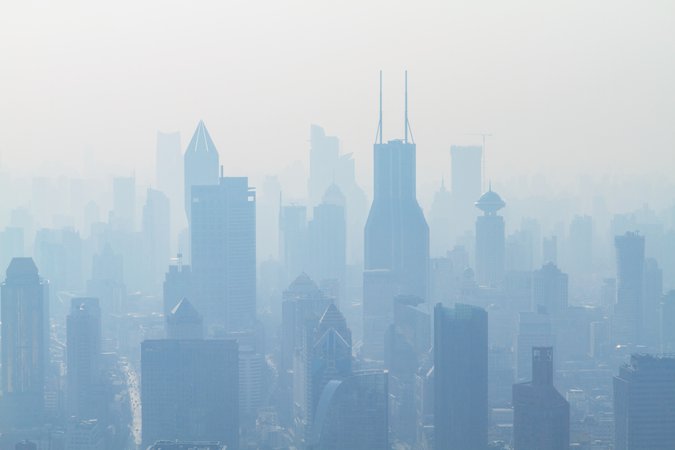Transforming Cap and Trade: Aligning Pollution Markets with Public Health Goals
This issue brief explores the benefits of a multipollutant cap-and-trade program in improving air quality, public health, and regulatory effectiveness.
1. Introduction
Air pollution is the leading environmental cause of death and disease globally (Wright and Pant, 2024). In 2021, household and ambient air pollution was the second leading risk factor for premature death, killing over 8.1 million people (Health Effects Institute 2024). Even in an energy-intensive world, many of these deaths are avoidable and can be prevented through the proper understanding and regulation of pollutants.
Although PM₂.₅ and ozone are considered to be the deadliest pollutants, there are hundreds of pollutants that can be harmful to human health (Ingram 2024). Currently, governmental bodies and policies take a fragmented approach to the research and regulation of these pollutants; different departments regulate different pollutants, and pollutants are studied and regulated independent of one another (Greenbaum and Shaikh 2010). This fragmentation in regulation includes cap-and-trade systems, which are used to manage the emissions of different pollutants such as CO₂, SO₂, and NO₂.
This issue brief will explore the concept of implementing a multipollutant cap-and-trade program, as opposed to the traditional single-pollutant model. This system would provide heterogeneous firms with a variety of emission permits to choose from, each representing a specified bundle of pollutants. Such a model would allow governments to regulate the total amount of each pollutant emitted while simultaneously accounting for the effects of pollutant interactions. While this issue brief focuses on the potential for a multipollutant cap-and-trade model, it is important to note that cap and trade is not the only regulatory strategy available. Direct command-and-control regulations—such as setting specific technology standards or emission limits for pollutants—also provide a pragmatic starting point (Stavins 2004). In fact, given the technical and institutional complexities involved in multipollutant assessment, establishing robust command-and-control frameworks may serve as a foundation from which a transition to a market-based multipollutant cap-and-trade system could be built over time.
This issue brief is associated with an accompanying working paper about the detailed structure of a multipollutant permit model (Kakeu 2025). Despite the technical and institutional barriers that have hindered the adoption of multipollutant regulations in recent history, there are many benefits associated with transitioning to multipollutant frameworks. This goes beyond replacing single-pollutant cap-and-trade systems with multipollutant ones; an overall restructuring of the methodologies, communication, research, and action on and about the health effects of air pollution to a more holistic perspective is imperative.
2. Multipollutant Air Quality Management
Since the dawn of modern environmental regulations in the United States and United Kingdom in the 1950s and 1960s, governments across the world have begun managing their emissions in some capacity. This has manifested in countries regulating their pollutants separately from one another. The Clean Air Act in the United States, the basis for much environmental policy domestically and internationally, includes a clause separating air quality standards for each “criteria pollutant.” Since pollutants are examined independently of one another, their methodologies can be centered around the characteristics of each pollutant; quantifying their health and environmental effects becomes more straightforward than a scenario where those methodologies must account for other pollutants too (Dominici et al. 2010).
Despite the relative ease of single-pollutant research and policymaking, it would be more efficient and effective to regulate air quality based on a multipollutant framework. Single-pollutant frameworks fail to adequately reflect the cumulative and interactive nature of pollutant exposures and their associated health risks. While it is true that specific pollutants may build up in certain areas, meaning different populations or communities are affected differently based on location, air masses will always contain a complex variety of pollutants (Kosmicki and Long 2016; Cushing et al. 2018). Single-pollutant frameworks fall short in the sense that they do not account for the mixture of multiple pollutants. When examining the health or environmental effects of pollutants, they only account for the individual impact of each pollutant, rather than the combined effects from the mixture (Dominici et al. 2010).
Scientific research has demonstrated that this mixture of substances can heighten the negative health effects of the pollutants (Kortenkamp and Faust 2018). This can be proven by dose addition; within a mixture, individual components contribute proportionally to their dose and potency, even with little individual impact. Experiments have demonstrated that the negative effects of a chemical mixture occur even when all contributing substances were present at or below their no observed adverse effect level. Even if pollutants are not harmful individually, a mixture of pollutants above a certain threshold could pose a health risk, as shown in Figure 1.
Figure 1. Cumulative Effects of Low-Level Pollutants on Health Risk

Source: Kortenkamp and Faust (2018).
The increased human health effects of multipollutant exposure, both in general and relative to single-pollutant exposure, have been noted across numerous studies. Huang et al. (2023) provides empirical evidence of exposure to air pollutant mixtures resulting in elevated mortality risk, with PM₂.₅ contributing the most to this phenomenon. PM₂.₅ is most concentrated in densely populated urban areas, often disproportionately impacting low-income populations (Declet-Barreto and Rosenberg 2022). In one study, multipollutant models were more effective in capturing the pediatric asthma-related health impacts of pollution than single-pollutant models (Winquist et al. 2014). Wu et al. (2023) provided evidence of long term joint pollutant exposure effects on cardiovascular outcomes, notably increased blood pressure in young adults exposed during adolescence, highlighting how early life exposure management through integrated multipollutant frameworks could achieve substantial public health benefits.
These multipollutant frameworks are imperative for fully understanding the health effects of exposure to a mixture of pollutants, and methodological advancements across a range of studies illustrate their applicable efficiency. In Winquist et al. (2014), the authors approach their multipollutant model by explicitly addressing correlated exposures, controlling for significant confounding factors and multicollinearity, thus avoiding overestimation or underestimation of risks associated with individual pollutants. A case study analyzing elderly mortality in São Paulo, Brazil, utilized advanced artificial neural network models; models that use multipollutant frameworks improved the accuracy of predicting health outcomes relative to those traditional single-pollutant frameworks (Leirião et al. 2023). The frameworks for multipollutant study are improving and their outcomes prove to be more accurate than those of single-pollutant methodologies, particularly in cases revolving around vulnerable populations.
Figure 2. Regional Health Impacts in Single- vs. Multipollutant Models

Source: Zhu et al. (2022).
Note: AP = air pollution; MPAP = multipollutant air pollution; SPAP = single-pollutant air pollution.
Another reason for switching entirely to a multipollutant research and policymaking approach is that methodological and monitoring infrastructure already exists, which could help support a transition. In terms of direct regulation, the US Food Quality Protection Act mandates the assessment of risks from multiple pesticides, with the evaluation methodologies being similar (Kortenkamp and Faust 2018). The US Environmental Protection Agency’s (EPA) Community Multiscale Air Quality Modeling System simultaneously measures the levels of multiple criteria pollutants (Dominici et al. 2010). At a more granular level, states can participate in EPA’s NCore Monitoring Network, a network of pollutant monitoring sites that all assess multiple criteria and noncriteria pollutants (EPA 2024a). With 79 locations around the country, this system allows state monitoring sites to conform to the same methodologies, which would allow future multipollutant policies to be based off the findings more easily.
Figure 3. All 79 NCore Monitoring Network Sites in the United States

Source: EPA 2024b.
Note: NCore = National Core.
In the United States, some of this analysis infrastructure has already been used to develop multipollutant management frameworks. The Georgia Environmental Protection Division has taken this approach for years, combining atmospheric sensitivity models with cost-benefit analyses and health estimations to produce an integrated multipollutant framework (Cohan et al. 2007). By acknowledging real-world factors, this approach has allowed for a more accurate human health analysis of pollution, which can lead to more effective policies targeting pollutants. In Europe, the European Parliamentary Research Service released a report in 2024 examining the effects of multipollutant exposure on human health (Forastiere et al. 2024). To combat these effects, the report argues the European Union needs to enact policies to increase the recognition of health impacts, reduce total and concentrated air pollution, and reduce demand for energy, transport, and livestock farming.
Exposure to multiple pollutants can result in increased risks to human health, and monitoring and analyzing pollutants separately underscores their true effects. When studying the effects of pollution, researchers have found that adopting multipollutant frameworks more effectively captures these real-world impacts. Around the world, many governments have taken steps to implement these structures in pollutant monitoring and research, laying the groundwork for policymaking changes.
3. Single-Pollutant Cap and Trade
Under the current single-pollutant cap-and-trade-model, a government limits the total amount of an individual pollutant that can be released by a set of firms (Hafstead 2022). Emissions are held to a limited level through permits that allow the firm to emit a certain amount of a pollutant. These permits are typically either allocated to specific firms or can be purchased in an auction, and from there can be traded based on a firm’s emission levels. One of the most common pollutants regulated by this system is CO₂, with over 50 governments around the world operating a CO₂ emissions trading system (World Bank Group 2023).
Figure 4. Emission Spillover Effects From Single-pollutant Regulation

Despite their widespread implementation, single-pollutant emissions trading systems have numerous limitations. Cap-and-trade systems are implemented as a method to manage the environmental and health effects of emissions, but simply regulating individual pollutants often does not result in any net change. Evidence suggests that regulating pollutants separately correlates with firms shifting their emissions to less regulated or unregulated pollutants (Kortenkamp and Faust 2018). Although an emissions trading system would cause firms to decrease their emissions of one pollutant, they may simply end up releasing a greater quantity of other pollutants so as to not limit their total industrial output. Firms may also shift their operations to areas with less overall pollution regulation; many of these areas are home to lower-income populations, placing the burden of improper regulation on more vulnerable communities. Polluters may take advantage of only one pollutant being regulated by employing strategies not addressed by the single-pollutant cap-and-trade programs, creating new risks in the process.
As examined by both Greenbaum and Shaikh (2010) and Kortenkamp and Faust (2018), single-pollutant regulation in the United States began with the Clean Air Act creating the National Ambient Air Quality Standards for “criteria pollutants.” In Europe and around the world, governments also regulate pollutants independently of one another, often with different departments or bodies managing pollutants from specific sectors, each using their own methodologies. These pollutant-specific silos have fostered fragmentation in policymaking, often leading to suboptimal outcomes. One instance of this can be found in China, where the commonly used Air Quality Index is single-contaminant oriented and does not account for the combined health effects of exposure to joint pollutants, thus underestimating the associated health risks (Zhu et al. 2022).
This fragmentation exists at the intergovernmental level as well; the World Health Organization (WHO) maintains global Air Quality Guidelines, which are set in combination with each country’s Air Quality Standards for criteria pollutants (World Health Organization 2025a). These guidelines are independently set for each pollutant as if they are separate from one another. Moreover, the WHO hosts a program known as AirQ+ which can assess the health impacts of air pollution on a given population (World Health Organization 2025b). In the methodology for this program, they acknowledge that one of its limitations is that it does not account for multiple exposure cases or multipollutant scenarios. As demonstrated in Figure 7, the standards set for pollutant releases are fragmented even at the highest levels of government.
Figure 5. Annual Nitrogen Dioxide and Particulate Matter Guidelines by Country


Source: World Health Organization (2025a).
Note: The map on the left shows the guidelines by country for nitrogen dioxide (NO₂) over a one-year averaging period, and the map on the right shows the guidelines for particulate matter (PM₂.₅) over the same period. Pollutant regulation is fragmented even at the highest levels of governance.
Multipollutant frameworks more accurately represent real-world exposure scenarios and have proven to be more effective in averting human health risks to air pollution. Current cap-and-trade markets take a single-pollutant approach to pollutant regulation; the evolution of these markets to adopting a multipollutant approach would yield a variety of health and environmental benefits.
4. Multipollutant Cap-and-Trade System
A multipollutant cap-and-trade system offers a flexible and market-driven approach to reducing emissions by regulating multiple pollutants simultaneously. Unlike traditional frameworks that set separate limits for each pollutant, this system establishes an overall emissions cap for multiple pollutants based on scientific assessments of environmental and public health goals. Addressing multiple pollutants together ensures a more holistic and efficient approach to pollution control.
Under this framework, regulatory agencies determine the total allowable emissions for each pollutant and issue multipollutant permits. Each permit is a bundled allowance that covers multiple pollutants, enabling firms to manage their emissions more effectively. Firms that reduce their emissions below their allotted levels can sell their unused permits back to the regulatory authority or trade them with other firms in a secondary market. This trading process creates a dynamic market where permit prices reflect the distribution of polluting firms, the portfolio of permits issued by the regulator, and the social value of reaching multipollutant emissions targets.
Figure 6. Relationships between Governments, Firms, and Permits in Multipollutant Trading Systems

The trading mechanism is designed to achieve a balance between the supply and demand for permits. Firms make decisions about buying or selling permits based on their operational efficiency, technological capabilities, and compliance costs. Over time, this market-based approach incentivizes firms to adopt cleaner technologies and innovative solutions, driving long term environmental and health benefits.
To ensure the system’s integrity, emissions are closely monitored through standardized reporting and verification mechanisms. Firms are required to submit detailed emissions data, which regulatory agencies use to enforce compliance and prevent fraudulent trading. Additionally, the system is designed to be adaptive, allowing regulators to adjust emissions caps as new scientific evidence, technological advancements, and environmental priorities emerge.
Figure 7. Example Structure of Permits

Note: Each permit is a bundle of multiple pollutant rights, allowing firms to release different pollutants at varying levels.
By regulating multiple pollutants within a single framework, a multipollutant cap-and-trade system maximizes environmental benefits while minimizing compliance costs. It aligns market incentives with sustainability goals, offering a dynamic and economically efficient solution to emissions control. This approach not only addresses the interconnected nature of pollutants but also fosters innovation and long-term environmental stewardship. A supplemental Resources for the Future (RFF) working paper, entitled Multipollutant Cap-and-Trade Systems with Heterogeneous Firms: An Optimal Transport Approach, develops the mathematical economics framework underlying the proposed multipollutant cap-and-trade system (Kakeu 2025). Drawing on mathematical tools from optimal transport theory, the framework formalizes the allocation of bundled permits across heterogeneous firms to maximize social welfare while ensuring compliance with aggregate environmental targets (Gangbo and McCann 1996; Galichon 2016). It provides a rigorous foundation for the system’s market architecture, including price formation mechanisms and stability conditions in multipollutant permit markets.
5. Challenges for Implementing Multipollutant Cap-and-Trade Systems
Transitioning from single-pollutant regulatory frameworks to comprehensive multipollutant cap-and-trade systems faces considerable institutional and regulatory hurdles. Currently, most regulatory systems—like those established under the US Clean Air Act—handle pollutants individually within separate agency responsibilities, leading to fragmented environmental governance. A 2010 article identified institutional inertia as a significant obstacle, as existing bureaucratic structures, staff expertise, and funding arrangements reinforce traditional single-pollutant regulations, hindering effective reform (Greenbaum and Shaikh 2010).
To address these challenges, a 2018 paper recommended implementing explicit legal mandates that require comprehensive multipollutant assessments (Kortenkamp and Faust 2018). Such mandates would give agencies clear direction and justification for integrating cumulative health impacts into regulatory decisions. The authors made a case for adopting temporary multipollutant assessment factors, safety buffers that work by applying an additional precautionary factor—such as a simple numerical reduction factor (for example, 10-fold)—to existing single-pollutant safety standards or permissible exposure limits. Additionally, a 2010 case study emphasized the importance of increasing interagency coordination to avoid overlapping mandates and conflicting efforts, proposing aligned regulatory schedules and shared scientific resources as practical solutions (Hidy and Pennell 2010).
Furthermore, significant scientific and methodological complexities also accompany multipollutant regulatory frameworks. A 2014 study conducted in Atlanta highlighted the challenges in accurately modeling interactions between multiple pollutants, as well as accounting for seasonal and nonlinear health responses (Winquist et al. 2014). Traditional methods often suffer from statistical issues, such as multicollinearity, which lead to inaccurate health risk assessments. More advanced computational techniques offer promising alternatives; for instance, the previously discussed 2023 case study in São Paulo successfully applied artificial neural networks—machine learning models that identify complex, nonlinear relationships in data—to predict health outcomes from combined pollutant exposures (Leirião et al. 2023).
Similarly, a 2023 analysis of adolescent exposure in Northern China employed quantile-based g-computation, a statistical method effective at quantifying joint effects of multiple pollutants on health outcomes, revealing significant cumulative cardiovascular risks from early life exposures (Wu et al. 2023). Quantile-based g-computation accomplishes this by dividing each pollutant into four quantiles and then evaluating how simultaneous increases in multiple pollutants across quantiles collectively influence health outcomes. Like artificial neural networks, this can also more effectively capture nonlinear interactions that traditional methods might miss. However, effectively applying these advanced approaches requires substantial investments in high quality data, monitoring networks, and analytic infrastructure.
To enhance policy relevance, comprehensive health-based indices have also emerged as valuable tools. Another Chinese study conducted in 2022 introduced the health-risk-based and multipollutant air quality index, a measure explicitly linking cumulative pollutant exposure to health impacts, as shown in Figure 2 (Zhu et al. 2022). This works by translating each pollutant’s concentration into an individual health-risk score based on scientifically established exposure-response relationships which are then aggregated to represent the overall health risk from the total pollutant mixture. The health-risk-based and multipollutant air quality index provides more accurate assessments of population health risks than traditional single-pollutant indices, but its integration into regulatory practice necessitates significant upfront investment in monitoring, data processing, and multidisciplinary expertise.
Market and industry responses represent additional implementation challenges. Industries familiar with single-pollutant or carbon-only markets face uncertainty regarding compliance strategies under multipollutant systems, affecting their technology and investment decisions. A 2007 integrated air quality management case study in Georgia demonstrated that clear regulatory signals and stable policy commitments are crucial to encouraging firms to adopt comprehensive emissions-reduction strategies (Cohan et al. 2007). Without strong economic incentives, industries may continue to prioritize short term pollutant-specific compliance measures over holistic solutions, potentially undermining broader air quality goals.
6. Conclusion
Air pollution remains a critical global health threat, yet existing regulatory systems often fall short due to their fragmented, single-pollutant approaches. In this policy brief, we highlighted substantial evidence indicating that multipollutant frameworks more accurately capture real-world pollutant exposures and their cumulative health impacts. Research consistently demonstrates that pollutant mixtures pose health risks greater than the sum of individual pollutants, necessitating regulatory methods that reflect these interactions to effectively protect public health.
Despite clear benefits, transitioning to a comprehensive multipollutant cap-and-trade system faces institutional inertia, regulatory fragmentation, methodological complexity, and market uncertainty. These obstacles, however, are not insurmountable. Policymakers can focus on creating explicit legal mandates requiring integrated assessments of multiple pollutants, investing in advanced data infrastructure, and fostering greater interagency cooperation. These foundational changes will pave the way for adopting effective analytical tools—such as multipollutant health risk indices and statistical methods like artificial neural networks and quantile-based g-computation—to enhance policy accuracy and effectiveness.
In the long run, shifting toward a multipollutant regulatory approach promises significant improvements in air quality and public health outcomes. By adopting holistic frameworks and clear market incentives, governments can reduce health disparities, drive technological innovation, and ensure environmental regulations more accurately reflect the complexities of air pollution. Ultimately, embracing a multipollutant perspective in research, policy, and practice is crucial for safeguarding human health and promoting environmental sustainability in the coming decades.






